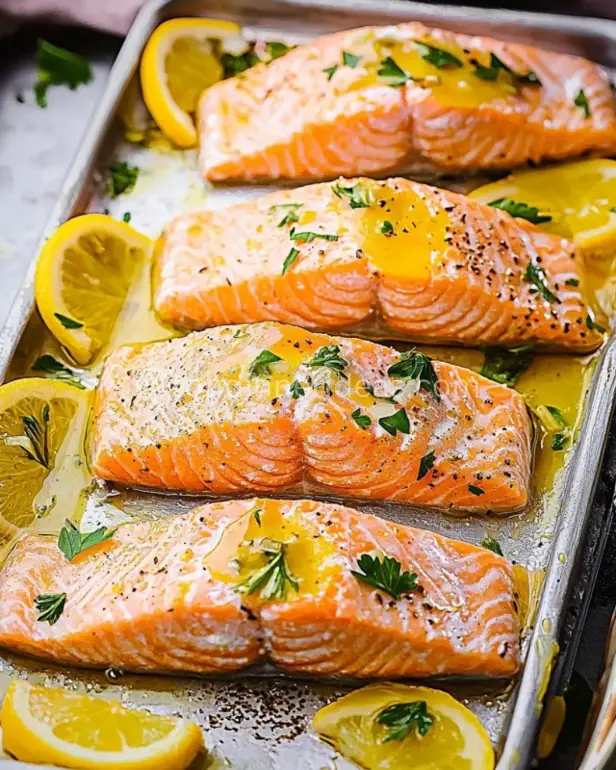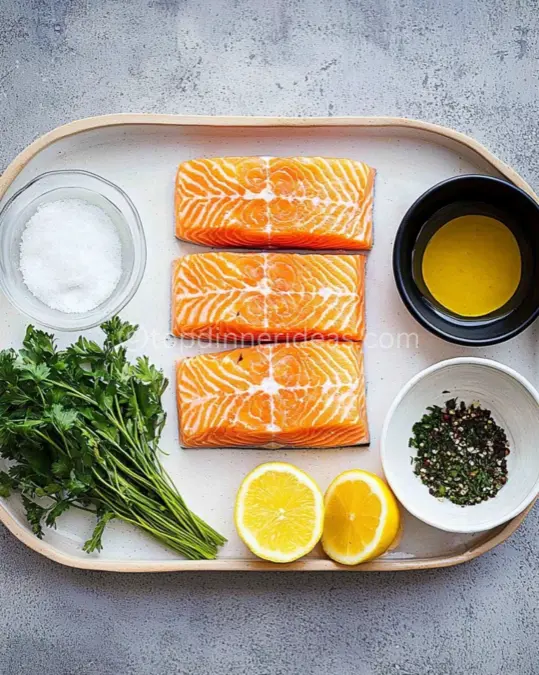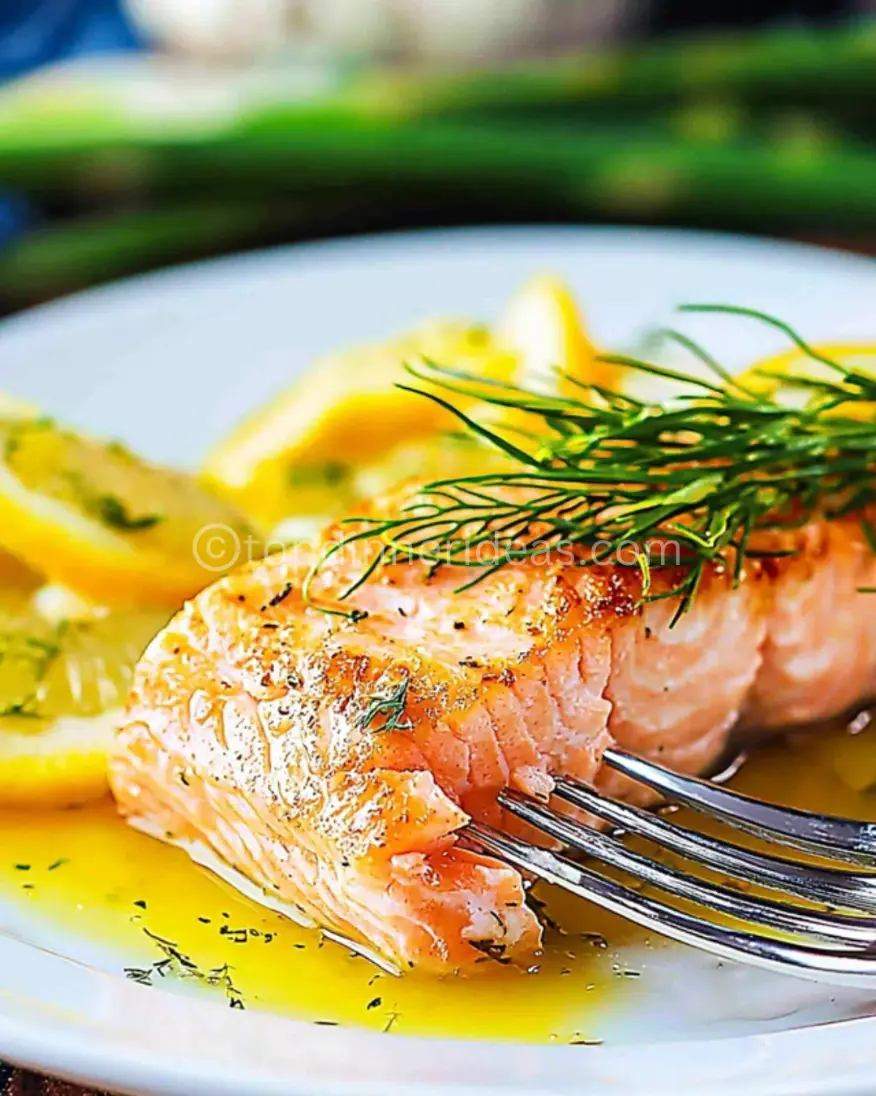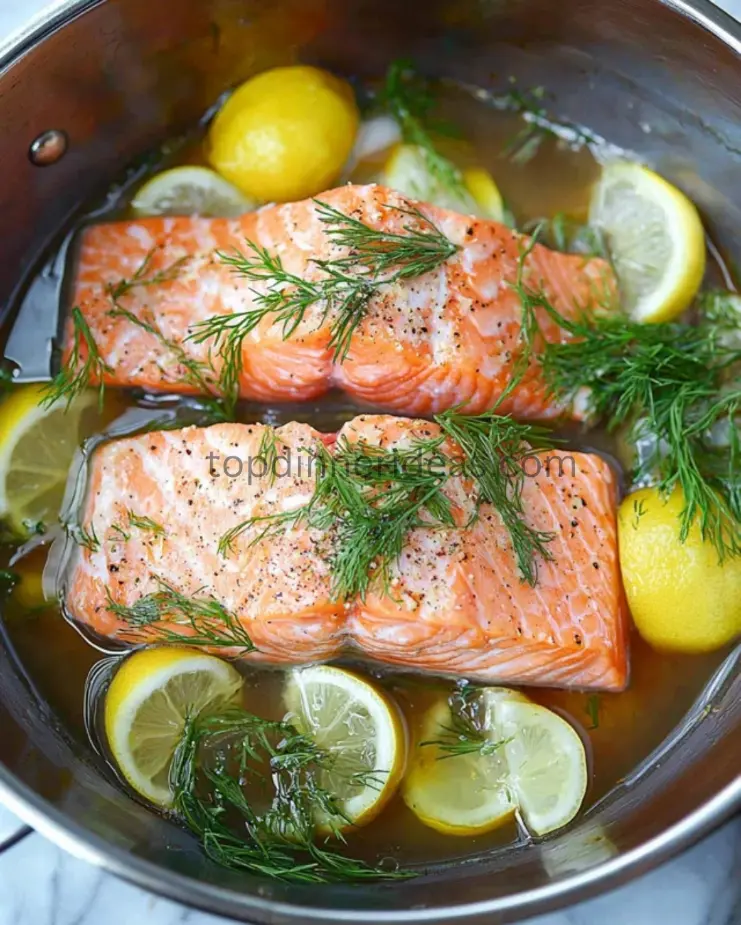Our Poached Salmon stands out as the best poached salmon recipe due to its versatile cooking methods, allowing you to choose between baking, using an air fryer, or even a microwave for quick preparation. This recipe incorporates various techniques such as butter poached salmon, coconut milk poached salmon, and olive oil poached salmon to cater to different taste preferences and dietary needs. Its adaptability ensures a delightful culinary experience every time you cook.

I vividly remember the first time I prepared a whole poached salmon for a family gathering. The gentle poaching process preserved the salmon’s natural moisture, resulting in a perfectly flaky and flavorful dish. Since then, poached salmon has become a staple in my kitchen, cherished for its simplicity and exquisite taste.
Equipments for Poached Salmon
When I’m cooking Poached Salmon, having the right equipment makes it seamless and enjoyable. Here are the essentials I always rely on:
- Large Pot or Skillet: Ideal for poaching the salmon fillets or whole salmon.
- Thermometer: To ensure the salmon reaches the perfect internal temperature.
- Slotted Spoon or Fish Turner: For safely lifting the salmon from the poaching liquid.
- Mixing Bowls: For preparing marinades or seasoning blends.
- Whisk: To mix sauces or dressings.
- Knife and Cutting Board: Essential for handling and preparing the salmon steaks.
- Aluminum Foil or Parchment Paper: To line baking sheets for easy cleanup.
- Optional: Air Fryer: If opting for the air fryer poached salmon method.
With these tools on hand, preparing this poached salmon recipe becomes simple and enjoyable, guaranteeing a delicious meal without any fuss.
Ingredients for Poached Salmon
Feel free to adjust the ingredients to match your personal taste or what you’ve got in your kitchen. I like to keep it flexible, so here’s what you’ll need for our Poached Salmon:
For the Poaching Liquid:
4 cups water or broth (vegetable or chicken broth for added flavor)
2 lemons, sliced
4 cloves garlic, smashed
4 sprigs fresh dill
2 bay leaves
Salt and pepper to taste

For the Salmon:
4 salmon fillets or steaks (6 oz each), preferably Atlantic salmon for its rich flavor
2 tablespoons olive oil or melted butter
Salt and pepper to taste
Optional: Fresh herbs, chopped for garnish
Optional Variations:
Butter Poached Salmon: Add 2 tablespoons butter to the poaching liquid for a richer flavor.
Coconut Milk Poached Salmon: Replace half of the poaching liquid with coconut milk for a creamy twist.
Cold Poached Salmon: Chill the poached salmon in the refrigerator for 2 hours and serve cold with a dill yogurt sauce.
Microwave Poached Salmon: Use a microwave-safe dish with a lid to poach salmon fillets quickly.
Instructions to Poached Salmon
Making Poached Salmon at home is so simple and rewarding. I like how it lets me whip up a healthy, flavorful meal with hardly any effort. Just follow these steps to create a dish that’s both delicious and satisfying:
Prepare the Poaching Liquid:
In a large pot or skillet, combine water or broth, white wine (if using), lemon slices, smashed garlic, fresh dill, bay leaves, salt, and pepper. Bring the mixture to a gentle simmer over medium heat.
Prepare the Salmon:
Pat the salmon fillets dry with paper towels to ensure the seasoning adheres properly. Season both sides with a pinch of salt and pepper.
Brush each salmon fillet with olive oil or melted butter for added moisture and flavor.

Poach the Salmon:
Gently place the salmon fillets or whole salmon into the simmering poaching liquid. Ensure the salmon is mostly submerged.
For Whole Poached Salmon: Carefully lower the entire salmon into the pot, ensuring even cooking. Poach for about 15-18 minutes, depending on the size and thickness of the fish.
For Salmon Fillets: Poach the fillets for 10-12 minutes, or until the salmon is opaque and flakes easily with a fork.
Optional: Air Fryer Blackened Salmon:
If you prefer an air-fried version, preheat your air fryer to 375°F (190°C).
After poaching, lightly coat the salmon with your preferred blackened salmon spice.
Place the salmon in the air fryer basket and cook for an additional 5 minutes to achieve a crispy exterior.
Bake the Poached Salmon:
Preheat your oven to 375°F (190°C).
Transfer the poached salmon to a baking sheet lined with aluminum foil or parchment paper.
Bake for an additional 5-7 minutes to enhance the flavors and finish cooking if necessary.

Rest the Salmon:
Once cooked, remove the salmon from the poaching liquid and let it rest on a plate for about 5 minutes. This allows the juices to redistribute, ensuring moist and tender meat.
Serve:
Garnish the poached salmon with fresh herbs and serve hot with your favorite sides such as steamed vegetables, rice, or a fresh salad.
For cold poached salmon, slice the fillets and serve over a bed of greens with a tangy dill yogurt dressing.
I love pairing my homemade Poached Salmon with a side of roasted vegetables or a fresh, light salad. It makes for a perfectly balanced and satisfying dinner!
Allergen Information for Poached Salmon
When I’m making Poached Salmon, I like to keep potential allergens in mind to make sure everyone can enjoy the meal safely. Here’s what I always pay attention to:
- Contains: Fish (salmon), Soy (if using soy-based marinades), Gluten (if using certain broths or seasonings), and Dairy (if using butter).
- Possible Cross-Contamination: Ensure that all utensils and surfaces are thoroughly cleaned if you have severe allergies, especially if preparing other dishes that contain common allergens like nuts or shellfish.
Understanding these allergen details helps me make informed choices and adjustments, ensuring a safe and enjoyable meal for everyone.
I like knowing this information because it allows me to accommodate dietary restrictions and avoid allergic reactions, making my cooking inclusive and thoughtful.
Substitutions for Poached Salmon
I like adapting the Poached Salmon recipe to suit different dietary needs, making it easy for everyone to enjoy this delicious dish. Here are some versatile substitution options:
- Gluten-Free Option: Use gluten-free soy sauce or tamari to replace regular soy sauce in marinades. Ensure that all other ingredients, like miso paste (if used), are also gluten-free.
- Dairy-Free Option: Omit the butter or use a dairy-free alternative like coconut oil. This maintains the moisture and flavor without dairy.
- Vegetarian/Vegan Option: Replace salmon with firm tofu or tempeh. Use plant-based marinades and broths to maintain the savory flavor.
- Keto Option: Ensure the honey or maple syrup is sugar-free by using keto-friendly sweeteners like erythritol or stevia.
- Ingredient Replacements:
- Salmon: Substitute with other fatty fish like mackerel, trout, or swordfish for varied flavors.
- Coconut Milk: Use almond milk or cashew milk as an alternative for a creamy twist.
- Olive Oil: Replace with avocado oil or melted coconut oil for different flavor profiles.
- Lime Juice: Use lemon juice for a slightly different citrus note.
- Fresh Herbs: Swap dill with parsley or cilantro for varied aromatic flavors.
These substitutions make it easy for me to adjust the dish to different dietary preferences without losing any of the great taste.
I prefer having these options because they let me customize the recipe to meet individual dietary needs, ensuring everyone can enjoy the deliciousness of Poached Salmon.
Variations of Poached Salmon
Once I’ve perfected the basic Poached Salmon recipe, I love finding new ways to personalize and enhance it. Here are some creative ideas to inspire your culinary adventures:
- Butter Poached Salmon: Add 2 tablespoons of butter to the poaching liquid for a richer and more indulgent flavor.
- Coconut Milk Poached Salmon: Replace half of the poaching liquid with coconut milk to infuse a creamy and tropical twist into the salmon.
- Cold Poached Salmon: Chill the poached salmon in the refrigerator for 2 hours and serve cold with a dill yogurt sauce or a citrus vinaigrette.
- Microwave Poached Salmon: Use a microwave-safe dish with a lid to poach salmon fillets quickly. Combine water, lemon slices, and herbs, cover, and microwave on high for 4-5 minutes.
- Oven Poach Salmon: Preheat your oven to 350°F (175°C). Place the seasoned salmon in a baking dish, add the poaching liquid, cover with foil, and bake for 15-20 minutes.
- Cedar Plank Poached Salmon: Use a cedar plank on the grill to infuse the salmon with a smoky flavor while poaching it with aromatic herbs and citrus.
- Blackened Poached Salmon: After poaching, coat the salmon with a blackened salmon spice blend and sear it in a hot cast-iron skillet for an extra layer of flavor and texture.
- Maple Miso Glazed Salmon: Incorporate maple syrup into the miso glaze for a sweet and savory combination that complements the poached salmon perfectly.
- Herb-Infused Poached Salmon: Add fresh herbs like rosemary, thyme, or basil to the poaching liquid for an aromatic and flavorful infusion.
- Spicy Poached Salmon: Incorporate chili flakes or a splash of hot sauce into the marinade to give the salmon an extra spicy kick.
I love how these variations spark creativity and let me tailor the recipe to my personal taste preferences and special occasions.
I prefer exploring these options because they keep the Poached Salmon exciting and versatile, allowing me to experiment with different flavor profiles and presentation styles.
Notes on Poached Salmon
I love enhancing and customizing my Poached Salmon with these helpful tips:
- Homemade Blackened Salmon Spice: Creating your own spice blend ensures freshness and allows you to adjust the flavors to your liking. Combine spices like paprika, garlic powder, onion powder, thyme, oregano, cayenne pepper, black pepper, salt, and cumin for a robust blend.
- Marinate Longer for More Flavor: For deeper flavor penetration, marinate the salmon for up to 2 hours in the refrigerator. Avoid marinating for more than 4 hours to prevent the fish from becoming mushy.
- Use High-Quality Salmon: Opt for wild-caught salmon for a richer flavor and better texture. Ensure the salmon steaks are fresh and have a vibrant color.
- Pat Dry Before Cooking: Always pat the salmon dry before applying the spice blend to ensure the seasoning adheres properly and to promote a crispy exterior.
- Customize Your Glaze: Adjust the sweetness and saltiness of the miso glaze by varying the amount of honey or soy sauce to suit your taste preferences.
- Garnish with Fresh Herbs: Sprinkle freshly chopped parsley or cilantro over the cooked salmon for added freshness and color.
- Serve Immediately: Poached salmon is best enjoyed fresh and hot. Serve immediately after cooking to maintain the optimal texture and flavor.
- Leftover Storage: Store any leftovers in an airtight container in the refrigerator for up to 2 days. Reheat gently in the oven to preserve the texture of the glaze.
- Pair with Complementary Sides: Enhance the meal by serving with sides like steamed vegetables, rice pilaf, or a quinoa salad to create a balanced and nutritious plate.
- Experiment with Cooking Methods: Try different cooking methods such as broiling for a caramelized top or poaching with different liquids like white wine or tea for varied flavor profiles.
These tips help you achieve the best results and make the cooking process smoother and more enjoyable.
I prefer using these additional tips because they help me refine my cooking techniques and customize the dish to better match my personal tastes and needs.

Health Benefits of Poached Salmon
I love indulging in our Poached Salmon because it’s not only a treat for my taste buds but also offers several health benefits. Here’s how the key ingredients contribute to my well-being:
Salmon:
- High in Omega-3 Fatty Acids: Supports heart health, reduces inflammation, and promotes brain function.
- Rich in Protein: Essential for muscle growth and repair.
- Vitamins D and B12: Important for bone health and energy metabolism.
Poaching Liquid (Water/Broth):
- Hydration: Helps maintain the moisture and tenderness of the salmon.
Olive Oil or Butter:
- Healthy Fats: Olive oil provides monounsaturated fats that are beneficial for heart health.
- Flavor Enhancers: Butter adds richness and depth to the salmon’s flavor.
Garlic and Ginger:
- Immune Boosters: Enhance the immune system’s ability to fight off infections.
- Anti-Inflammatory Properties: Help reduce inflammation in the body.
Lemon Juice:
- Vitamin C: Enhances immune function and promotes healthy skin.
- Antioxidants: Protect against cell damage and aging.
Bell Peppers and Onions:
- Vitamins A and C: Boost the immune system and promote healthy skin.
- Fiber: Aids in digestion and maintains bowel health.
Blackened Salmon Spice Blend:
- Antioxidants: Spices like paprika and cayenne pepper are rich in antioxidants that help combat free radicals.
- Anti-Inflammatory Properties: Ingredients like garlic powder and onion powder can reduce inflammation in the body.
I enjoy including this dish as part of a balanced diet because it supports my overall health and well-being. I prefer to savor it in moderation to maintain a healthy lifestyle.
I like understanding the health benefits of the ingredients because it allows me to make informed choices about my diet and appreciate the nutritional value of my meals.
Nutrition Facts
By understanding the nutritional content of Poached Salmon, I can make informed dietary choices. Here’s a breakdown per serving:
- Calories: 450 kcal
- Protein: 35g
- Fat: 25g
- Saturated Fat: 5g
- Carbohydrates: 10g
- Sugar: 5g
- Fiber: 1g
- Sodium: 800mg
I like that the nutritional profile of Poached Salmon makes it a protein-rich meal option, providing a substantial amount of protein to support muscle growth and repair while keeping carbohydrates relatively low. I appreciate that the fat content is balanced with healthy fats from olive oil and salmon, though I prefer to enjoy it in moderation due to the saturated fat and sodium levels.
I like knowing the nutritional information because it helps me incorporate this dish into my dietary plan, ensuring it aligns with my nutritional goals.
Nutritional values can vary based on specific ingredient brands and measurements used. For more precise information, refer to the labels of your chosen ingredients.
Cooking Tips for Poached Salmon
Mastering the art of cooking Poached Salmon becomes so much easier with a few expert tips I like to follow:
- Use Fresh Ingredients: Fresh salmon and high-quality spices make a significant difference in flavor and texture.
- Pat the Salmon Dry: Before applying the spice blend, pat the salmon dry to ensure the seasoning adheres properly and promotes a nice crust.
- Preheat the Oven or Grill: Ensure your cooking surface is properly preheated to achieve even cooking and prevent sticking.
- Monitor Cooking Time: Salmon cooks quickly. Keep an eye on it to prevent overcooking, which can lead to dry fish.
- Apply the Spice Blend Evenly: Use a brush or your hands to spread the blackened salmon spice evenly over the salmon to ensure consistent flavor in every bite.
- Baste During Cooking: For extra flavor, baste the salmon with additional glaze or oil halfway through the cooking process.
- Let It Rest: Allow the salmon to rest for a few minutes after cooking to let the juices redistribute, ensuring moist and tender meat.
- Experiment with Flavors: Feel free to add other flavors to the spice blend, such as smoked paprika for added depth or a touch of brown sugar for sweetness.
- Serve Immediately: Poached salmon is best enjoyed fresh and hot. Serve immediately after cooking to maintain the optimal texture and flavor.
- Pair with Complementary Sides: Enhance the meal by serving with sides like steamed vegetables, rice pilaf, or a quinoa salad to create a balanced and nutritious plate.
Perfectly cooked and flavorful Poached Salmon is easy to achieve with these techniques. I like relying on these tips to deliver consistently delicious dishes and elevate my overall cooking experience.
Storage Advice for Poached Salmon
Properly storing Poached Salmon helps keep it fresh and delicious for future meals. Here’s what I like to do:
- Refrigeration: Store leftover poached salmon in an airtight container in the refrigerator for up to 2 days. Keep the glaze separate if possible to maintain its integrity.
- Freezing: For longer storage, place the salmon in a freezer-safe bag or container and freeze for up to 3 months. Thaw overnight in the refrigerator before reheating.
- Reheating: Reheat the salmon gently in the oven at 350°F (175°C) for about 10 minutes to restore its original texture. Avoid microwaving, as it can make the glaze soggy.
- Preventing Sogginess: If storing with tortillas, reheat them separately just before serving to maintain their texture. Store any additional toppings in separate containers.
- Labeling: Clearly label containers with the date to keep track of freshness and ensure timely consumption.
- Leftover Reuse: Transform leftover poached salmon into other dishes such as salads, sandwiches, or rice bowls for added variety.
With proper storage techniques, your Poached Salmon will stay fresh and ready to enjoy later.
Smart storage practices reduce waste while ensuring you have tasty meals on hand when needed.
Serving Suggestions for Poached Salmon
Serving poached salmon with a bit of flair can really make your meal special. Here are some thoughts to spark your presentation ideas:
- With Steamed Rice: Serve the salmon over a bed of fluffy steamed rice, drizzled with any remaining glaze.
- Accompanied by Roasted Vegetables: Pair with roasted carrots, Brussels sprouts, or asparagus for a colorful and nutritious meal.
- In a Rice Bowl: Create a hearty rice bowl with poached salmon, avocado slices, cucumber, and a sprinkle of sesame seeds.
- With a Fresh Green Salad: Complement the rich flavors of the salmon with a crisp green salad dressed in a light vinaigrette.
- On Top of Noodles: Place the salmon over a serving of soba or udon noodles tossed in a soy-based sauce.
- With Pickled Vegetables: Add a side of pickled ginger or radishes to provide a tangy contrast to the savory salmon.
- In Lettuce Wraps: Use large lettuce leaves as wraps for the salmon and vegetables for a low-carb option.
- With a Citrus Glaze: Add a fresh squeeze of lemon or lime juice over the salmon for an extra burst of flavor.
- With a Side of Quinoa: Serve alongside quinoa mixed with herbs and vegetables for a nutritious and filling meal.
- As Part of a Bento Box: Include the poached salmon in a bento box with rice, vegetables, and a small portion of pickles for a complete and visually appealing meal.
These serving ideas not only make things look great but also ensure a well-rounded and yummy meal.
Checking out these serving suggestions lets you mix things up and present your dishes in a really attractive and tempting way.
Troubleshooting Poached Salmon
Having trouble getting your poached salmon just right? Here are some common hiccups and how to fix them so your dish comes out perfect:
- Salmon Overcooked and Dry: Use a meat thermometer to check for an internal temperature of 145°F (63°C). Remove the salmon from the oven or grill as soon as it reaches this temperature to prevent overcooking.
- Spice Blend Not Adhering Properly: Ensure the salmon is patted dry before applying the spice blend. Applying a thin layer of oil can help the spices stick better. Alternatively, marinating the salmon can enhance the adherence of the spice blend.
- Glaze Too Salty: Adjust the amount of soy sauce in the miso sauce or opt for a low-sodium soy sauce. Balance the flavors with additional sweeteners like honey or maple syrup if necessary.
- Glaze Too Sweet: Reduce the amount of honey or maple syrup in the miso glaze. Add a splash of rice vinegar or lime juice to balance the sweetness with acidity.
- Salmon Sticking to the Baking Sheet or Grill: Line the baking sheet with aluminum foil or parchment paper and lightly grease it with oil. For grilling, ensure the grates are well-oiled and preheated to prevent sticking.
- Glaze Burns Before Salmon is Cooked: Apply the glaze towards the end of the cooking process, such as the last 5-10 minutes of baking or grilling, to prevent it from burning while the salmon cooks through.
- Lack of Flavor: Adjust the seasoning by adding more spices or herbs to the spice blend. Incorporate fresh lime juice or a splash of hot sauce for an extra flavor boost.
- Uneven Cooking: Arrange the salmon steaks in a single layer with space between them to ensure even heat distribution. Rotate the baking sheet or turn the salmon halfway through cooking for uniform results.
These fixes will help you get past those common snags and make delicious poached salmon every single time. Knowing how to handle these little problems means you can consistently whip up top-notch dishes, which boosts your cooking confidence and skills.
FAQ About Poached Salmon
Poached salmon pairs well with sides like steamed vegetables, quinoa, rice pilaf, roasted potatoes, or a fresh green salad. Adding a citrusy vinaigrette or a dollop of dill yogurt sauce can also enhance the meal.
Complement your poached salmon with sides such as garlic butter noodles, roasted asparagus, sautéed spinach, or a quinoa and vegetable medley. Freshly steamed broccoli or a cucumber and tomato salad also make excellent accompaniments.
If opting to bake poached salmon in the oven, preheat to 375°F (190°C) and bake for approximately 15-20 minutes, or until the salmon flakes easily with a fork and reaches an internal temperature of 145°F (63°C).
Serve poached salmon with sides like wild rice, mashed sweet potatoes, roasted Brussels sprouts, or a citrus salad. Additionally, a side of lentil or bean salad can provide a hearty and nutritious complement.
While cheese isn’t typically paired with poached salmon, you can add a sprinkle of feta or goat cheese for a tangy contrast if desired. Alternatively, omit the cheese for a pure and delicate flavor experience.
Poached salmon is a technique rooted in traditional European cooking, particularly in French cuisine. Poaching is a gentle cooking method that preserves the salmon’s delicate texture and flavor.
Baking poached salmon at 350°F (175°C) typically takes about 18-20 minutes. However, cooking times can vary based on the thickness of the salmon fillets, so using a meat thermometer is recommended for precision.
Yes, you can freeze poached salmon. Allow the salmon to cool completely, then wrap it tightly in plastic wrap and place it in a freezer-safe bag or container. It can be frozen for up to 3 months. Thaw overnight in the refrigerator before reheating.
Yes, plain poached salmon without any seasoning or additives is safe for dogs in moderation. However, avoid adding salt, butter, or other seasonings that can be harmful to dogs.
Poached salmon can last in the refrigerator for up to 3 days when stored in an airtight container. For the best quality, consume within this timeframe and reheat gently before serving.
Yes, you can poach salmon without oil by using a flavorful poaching liquid such as broth, water, or a mixture of citrus juices and herbs. This method ensures the salmon remains moist and tender without added fats.
These answers address common concerns and help you make the most of your Poached Salmon experience.
Knowing the answers to these FAQs ensures you have the information needed to successfully prepare and enjoy this delicious dish.
Footnotes for Poached Salmon
Starting your poached salmon adventure opens up a whole world of kitchen fun! Feel free to play around with different ingredients and ways of doing things to make this recipe totally yours. Whether you’re adding a bit of heat with chili flakes or tossing in fresh herbs for a lovely smell, your own special touch will make the dish one-of-a-kind. Happy cooking, and enjoy the tasty journey of your homemade poached salmon!
For more delicious recipes and cooking tips, Navigate to our Main Dishes section, or visit Trustedrecipe. Thank you for choosing this recipe, and may your kitchen adventures be tasty and enjoyable!



